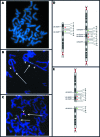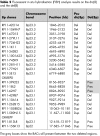Inversion polymorphisms and non-contiguous terminal deletions: the cause and the (unpredicted) effect of our genome architecture
- PMID: 16648372
- PMCID: PMC2564524
- DOI: 10.1136/jmg.2005.037671
Inversion polymorphisms and non-contiguous terminal deletions: the cause and the (unpredicted) effect of our genome architecture
Abstract
Molecular definition at the BAC level of an 8p dicentric chromosome and an 8p deleted chromosome is reported in a patient with two different cell lines. The dicentric, which differed from that generating the recurrent inv dup del(8p) for the location of its break point, originated during the paternal meiosis on the background of the classical 8p23.1 inversion polymorphism. The breakage of this dicentric gave rise to the 8p deleted chromosome which, as a result of the inversion, had two non-contiguous deletions. These findings confirm previous data on 1p distal deletions, showing that at least some of the deletions stem from the breakage of dicentric chromosomes. They suggest that non-contiguous deletions may be frequent among distal deletions. This type of rearrangement can easily be overlooked when two contiguous clones, one absent and the other present by FISH analysis, are taken as boundaries of the deletion break point; in this case only high resolution array-CGH will reveal their real frequency. The definition of such non-contiguous distal deletions is relevant for phenotype/karyotype correlations. There are historical examples of blunders caused by overlooking a second non-contiguous deletion. This paper shows how small scale structural variations, such as common polymorphic inversions, may cause complex rearrangements such as terminal deletions.
Conflict of interest statement
Conflicts of interest: none declared
References
-
- Youssoufian H, Pyeritz R E. Mechanisms and consequences of somatic mosaicism in humans. Nat Rev Genet 20023748–758. - PubMed
-
- Hassold T, Hunt P. To err (meiotically) is human: the genesis of human aneuploidy. Nat Rev Genet 20012280–291. - PubMed
-
- Daniel A, Wu Z, Darmanian A, Malafiej P, Tembe V, Peters G, Kennedy C, Ades L. Issues arising from the prenatal diagnosis of some rare trisomy mosaics—the importance of cryptic fetal mosaicism. Prenat Diagn 200424524–536. - PubMed
-
- Robinson W P. Mechanisms leading to uniparental disomy and their clinical consequences. Bioessays 200022452–459. - PubMed
-
- Floridia G, Piantanida M, Minelli A, Dellavecchia C, Bonaglia C, Rossi E, Gimelli G, Croci G, Franchi F, Gilgenkrantz S, Grammatico P, Dalpra L, Wood S, Danesino C, Zuffardi O. The same molecular mechanism at the maternal meiosis I produces mono‐ and dicentric 8p duplications. Am J Hum Genet 199658785–796. - PMC - PubMed
Publication types
MeSH terms
Grants and funding
LinkOut - more resources
Full Text Sources




